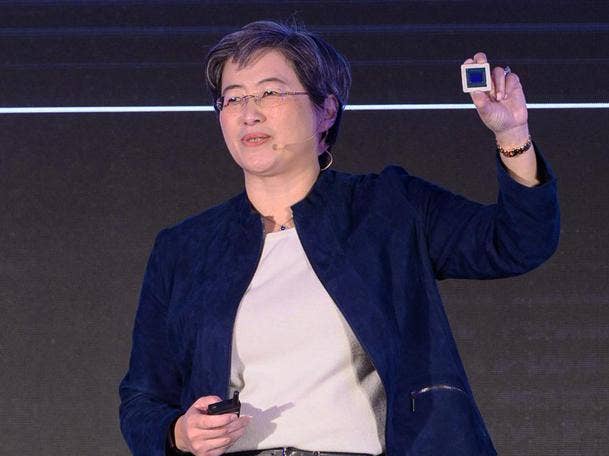AMD CEO Lisa Su: Roadmap Execution Is Key To Fighting Intel
Su says the chipmaker achieved its goal of achieving double-digit market share in servers against Intel as the chipmaker‘s revenue for EPYC processors more than doubled in the second quarter from the same period last year. ‘When we talk to our customers, it‘s about ensuring that they understand we have a consistent roadmap,’ she says.

AMD CEO Lisa Su said the company‘s roadmap for next-generation processors and GPUs remains on track as the company’s ability to “consistently” execute on product plans set out years in advance remains ”key” in the chipmaker’s battle against rival Intel.
Su made the remarks on AMD‘s second-quarter earnings call Tuesday, where multiple analysts asked the CEO how she feels about the company’s roadmap in light of Intel's 7-nanometer product delay, disclosed last week, that was caused by manufacturing issues.
[Related: Top Intel Exec Murthy Renduchintala To Leave After 7nm Stumble]
“When we talk to our customers, it‘s about ensuring that they understand we have a consistent roadmap that is pushing the leading edge of performance and ensuring that we deliver the performance improvements that we promised,” she said.
In her opening comments, Su said the company plans to start shipping next-generation, 7-nanometer Zen 3 processors, including its EPYC Milan CPUs, as well as next-generation GPUs based on its RDNA 2 architecture for gaming and CDNA architecture for data centers in the second half of the year.
Those plans are in line with a major roadmap update AMD provided during its Financial Analyst Day in March, where the company said its 5nm Zen 4 architecture is on track for launch in 2022 with EPYC Genoa processors.
Su said AMD is already starting to engage customers on its Zen 4 processors, which represents in part the eagerness of customers to understand the company‘s long-term roadmap.
“We feel that customers are very open across cloud, OEM, enterprise. It‘s on us to execute, and we think about that every day,” she said. ”But in terms of where the roadmap is, what are we trying to accomplish, where the customers are, there’s a pull from customers to engage us across a number of workloads.”
AMD‘s stock price was up more than 10 percent in after-hours trading after reporting second-quarter revenue of $1.93 billion, a 26 percent increase over the same period last year and $70 million higher than Wall Street expectations. that the chipmaker said was largely driven by Ryzen and EPYC processors more than doubling. AMD’s net earnings were 18 cents per share, beating analyst estimates by 1 cent.
Sales to date and strong demand signals for the company‘s existing and upcoming products in the second half of 2020 prompted AMD to upgrade its full-year revenue growth forecast to roughly 32 percent from a previous guidance of approximately 25 percent, plus or minus 5 points, given in April.
Su said the company reached its goal of achieving double-digit market share in servers against Intel as the chipmaker‘s revenue for EPYC processors more than doubled in the second quarter, thanks to “broad, high-volume adoption.” The company’s server products overall represent more than 20 percent of its $1.93 billion revenue this quarter, she added, though it was weighted heavily toward EPYC versus AMD’s Radeon data center GPUs, which will receive a refresh with the upcoming CDNA parts.
“Our strategy around machine learning is partnered deeply with a couple of large cloud vendors who can invest in software with us, and we see that as a multi-year opportunity,” Su said of AMD‘s data center GPU business. ”But it’s not a big revenue contributor here in 2020, [though] we see growth opportunity as we go into 2021 and beyond.”
Aside from strong EPYC sales, Su said the company‘s Ryzen processor sales more than doubled in the quarter from the same period last year, largely thanks to significant growth of the company’s new Ryzen 4000 mobile processors, which presented the company’s fastest product ramp in that category.
Su said while the company‘s “growing nicely in commercial PCs,” the chipmaker is still underrepresented in the segment.
“No question that commercial notebook is a big focus for us, and we‘re going to continue to invest and hopefully make progress in that sub-segment,” she said.
With AMD continuing to demonstrate strong execution on its roadmap and Intel struggling with 7nm products, the dynamics are giving customers more reasons to check out AMD as a viable processor vendor, according to an executive at a solution provider company that partners with Intel and AMD.
“If you look at AMD now, their next generation is well on its way,” said the executive, who asked to not be identified to speak frankly about Intel. ”I‘ve got some customers looking at that, and here’s Intel just losing ground. It makes selling the Intel story a little tougher.”